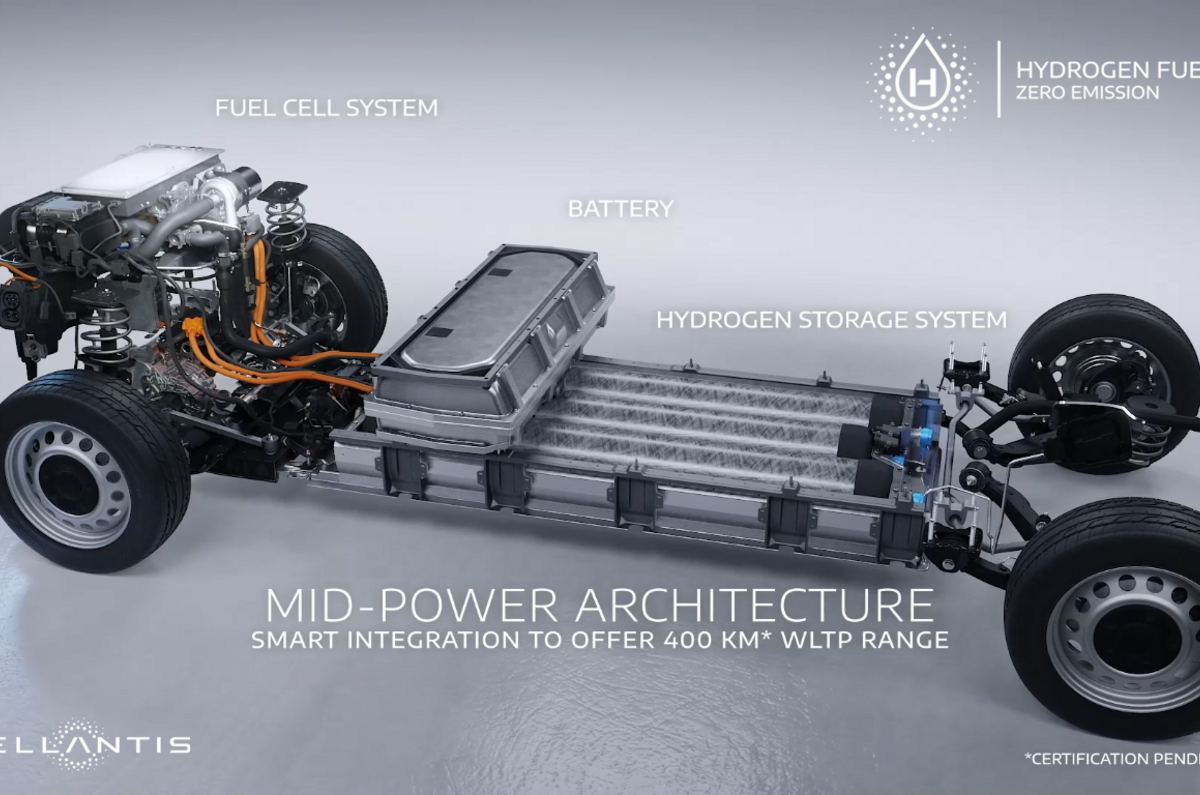Stellantis has increased its range of zero-emissions light commercial vehicles (LCVs) with a plug-in hydrogen van that will be available from Citroën, Peugeot and Vauxhall retailers.
Based on the same architecture as the battery-electric versions of the Citroën Dispatch, Peugeot Expert and Vauxhall Vivaro, the new mid-size van can store 4.4kg of liquid hydrogen under its cargo area floor at a pressure of 700bar, with an additional 10.5kWh battery housed under the seats. The rest of the fuel cell system and electric motor lie within the engine bay.
As a result of this packaging solution, the hydrogen van offers the same payload and cargo volume as the equivalent ICE model (up to 1100kg and 6100 litres respectively). It has a 250-mile range and can be refilled with hydrogen in three minutes – a similar time to diesel models.
The battery element, adapted from Stellantis's plug-in hybrid vans, can be recharged in roughly an hour at a rate of 11kW. Battery-only running is possible for up to 30 miles.
Maximum power is 134bhp and maximum torque is 192lb ft, giving the van a 0-62mph time of 15sec and a top speed of 81mph. It's also capable of towing up to a tonne.
Stellantis claims that the move towards hydrogen is as a result of customer demand - research conducted by the company has shown that its range of battery-electric vans don’t give certain customers sufficient range.
Although 83% of its customers drive fewer than 125 miles per day and 44% never drive more than 185 miles a day, that still leaves a significant proportion who require more range and faster refill times than is currently available.
Despite the hydrogen van's launch, planned in left-hand-drive for the end of 2021 with the UK following afterwards, there are still four challenges remaining around the fuel, according to Stellantis.
These are full-scale production of green hydrogen, a network of hydrogen filling stations, integration of fuel cell systems into vehicle architecture and cost. As a result, Stellantis will continue to offer multiple propulsion options.
READ MORE
Stellantis: the facts & brands behind the world's newest car giant
UPS orders 10,000 electric vans from British start-up Arrival









Join the debate
Add your comment
So in other words it has not launced, at least not in the uk and no price is mentioned, joke of a van. And how in the name of all that's holy does it take 15 seconds to get to 60 with 134hp in a light small van. Sales will be single figures and to dealers only, like the Mirrai
They said that the vans can be ordered by the end of this year.
The Opel Special Vehicles is currently assembling pre-production vehicles. This is said to also to train workers in the assembly plants (Hordain/Lieu-Saint-Amand in northern France, not far from Valenciennes, the former Selvel Nord).
Mind you, at Opel they had built the Hydrogen3 and Hydrogen4 in the body of an Opel Zafira, 20 and 14 years ago. So there is experience, and based on that experience a task force was formed in Rüsselsheim after Opel was acquired by PSA from GM.
What is shown now did not start after the merger to Stellantis, but three years ago.
PS: Why does the edit bar have the chain symbol for entering an link if "embedded links are not allowed in comments"? This is inconsistent.
On a further note, the vehicle will be available initually only in Left Hand Drive versions, so not (yet) a Vauxhall Vivaro on H₂ for the island.
re 0-62 time. The all electric version does it in 13.1 seconds. Perhaps this is down to gearing in this hydrogen version, to make it more efficient.
I like the concept, and indeed there should be a ready supply of green hydrogen if the planned expansion of wind turbines comes to fruition. That said, the article fails to mention important facts such as the likely cost, weight or production volume of this vehicle.
While you're right that they don't quote the weight, they clearly state the payload is the same so there is no weght penalty apparently.
I also live in a built up city, and getting an electric car charged when you are in a flat is a faff at best. There are a bank of chargers in an industrial estate not far from me, but these always have Car Club vehicles in them. Our city centre doesn't have one on street charger in it, there are no countil run chargers to my knowledge. If I were to get an electric car, my issue is not range, but where to charge.